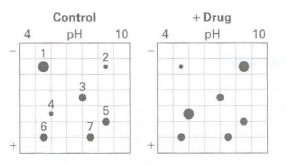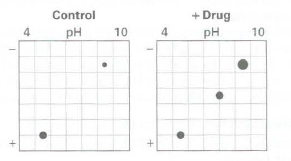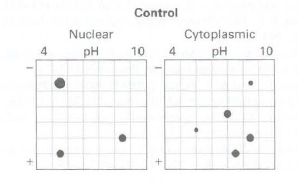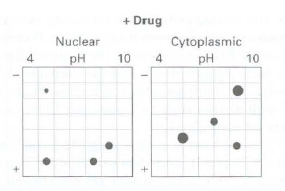Proteomics involves the global analysis of protein expression. In one approach, all the proteins in control cells
Question:
a. Cells arc treated with a drug ("1 Drug") or left untreated ("Control"), and then proteins are extracted and separated by two-dimensional gel electrophoresis. The stained gels are shown below. What do you conclude about the effect of the drug on the steady-state levels of proteins 1-7?

b. You suspect that the drug may be inducing a protein kinase and so repeat the experiment in part (a) in the presence of 32P-labeled inorganic phosphate. In. this experiment the two-dimensional gels are exposed to x-ray film to detect the presence of 32P-Iabeled proteins. The x-ray films are shown below. What do you conclude from this experiment about the effect of the drug on proteins 1-7?

c. To determine the cellular localization of proteins 1-7, the cells from part (a) were separated into nuclear and cytoplasmic fractions by differential centrifugation. Twodimensional gels were run, and the stained gels are shown below. What do you conclude about the cellular localization of proteins 1-7?


d. Summarize the overall properties of proteins 1-7, combining the data from parts (a), (b), and (c). Describe how you could determine the identity of any one of the proteins.
Step by Step Answer:

Molecular Cell Biology
ISBN: 978-1429234139
7th edition
Authors: Harvey Lodish, Arnold Berk, Chris A. Kaiser, Monty Krieger, Anthony Bretscher, Hidde Ploegh, Angelika Amon, Matthew P. Scott





